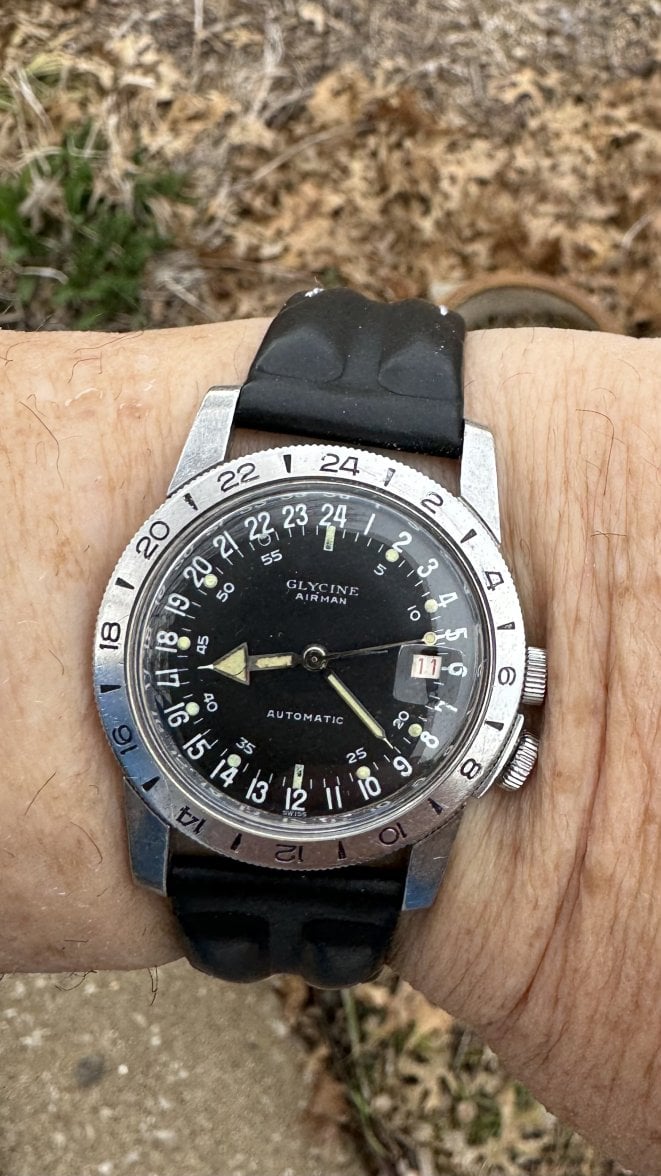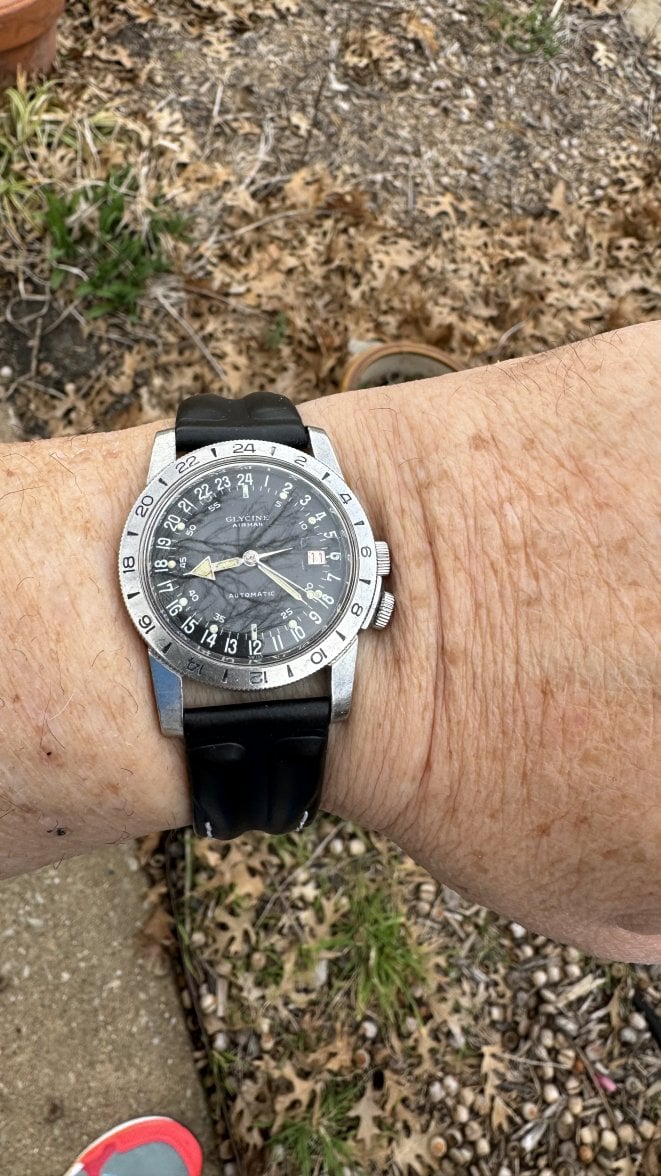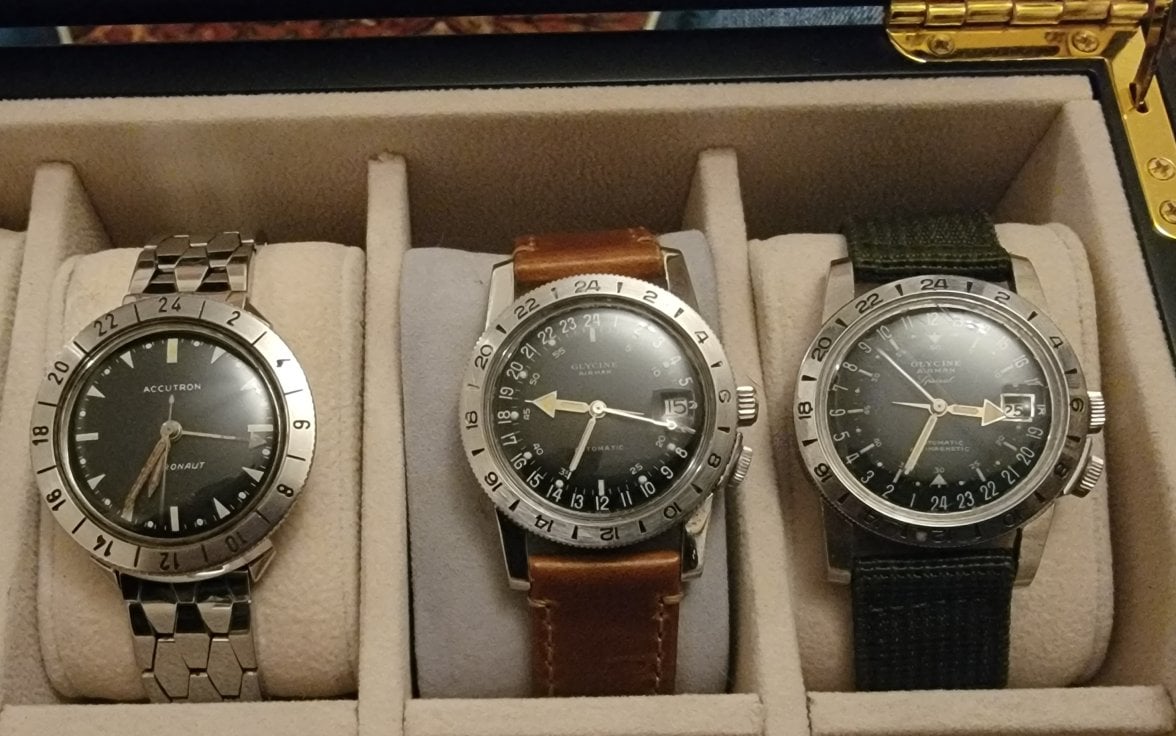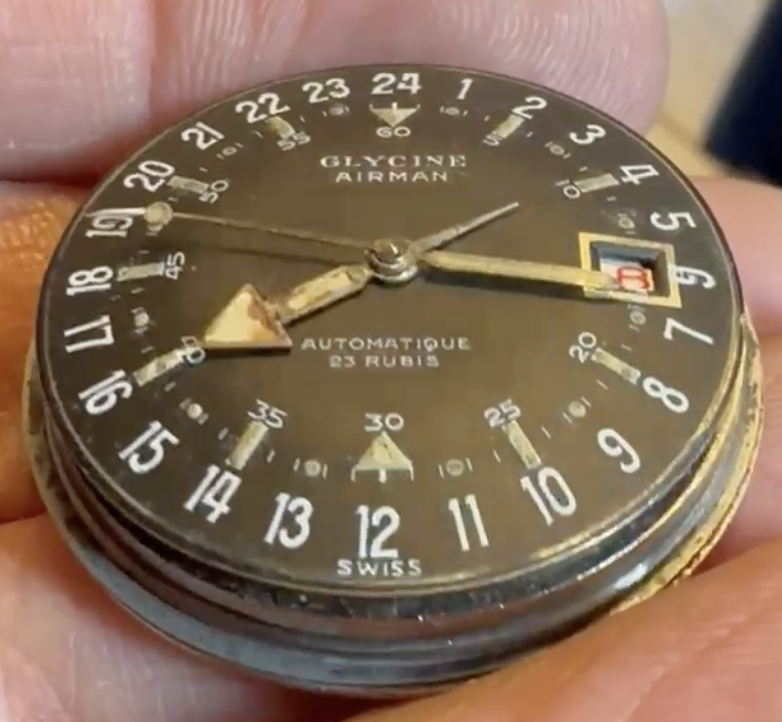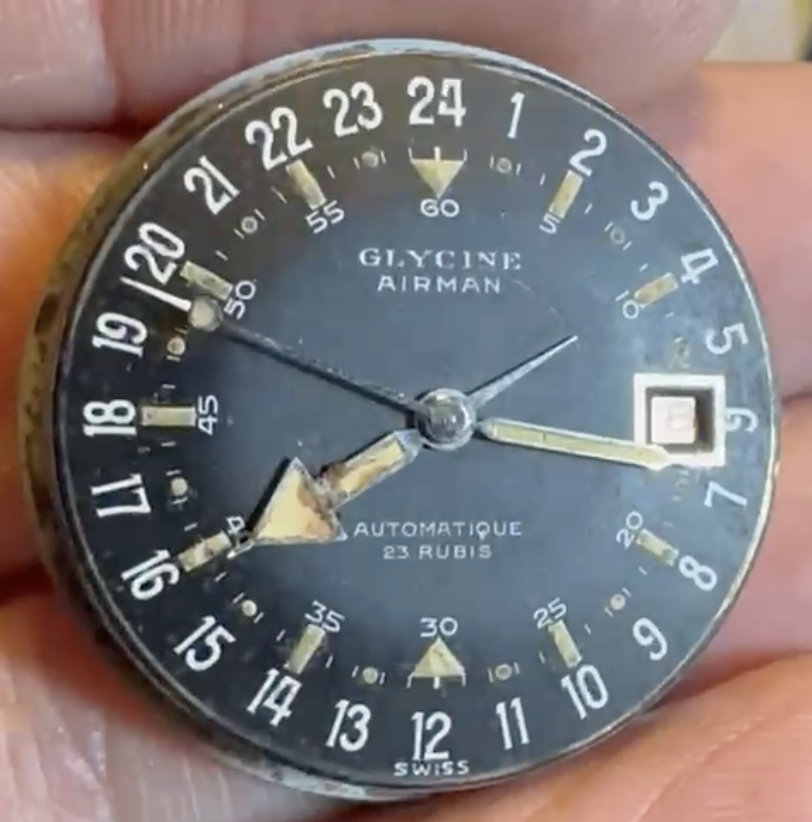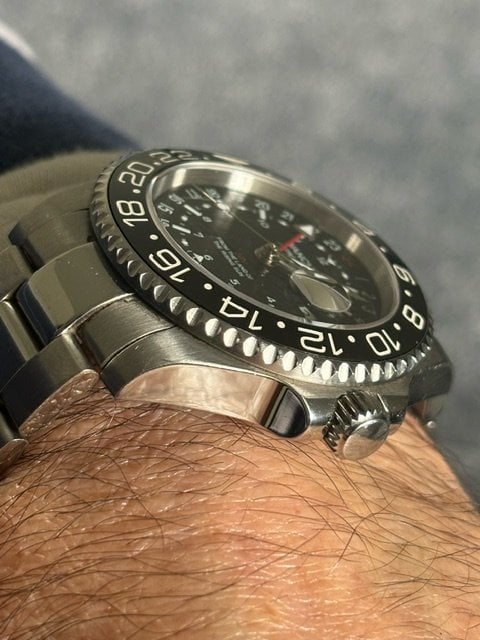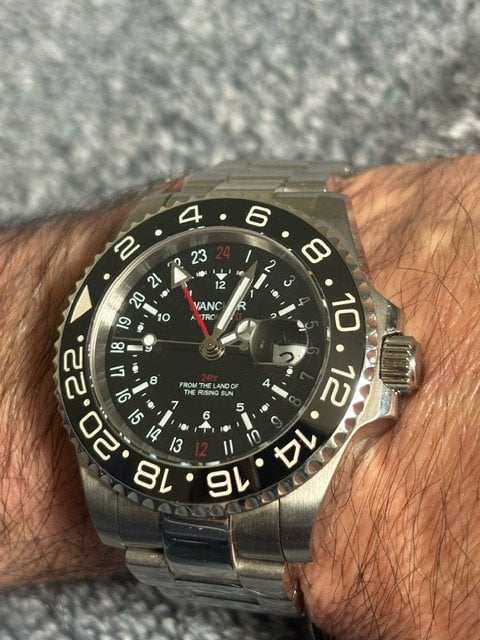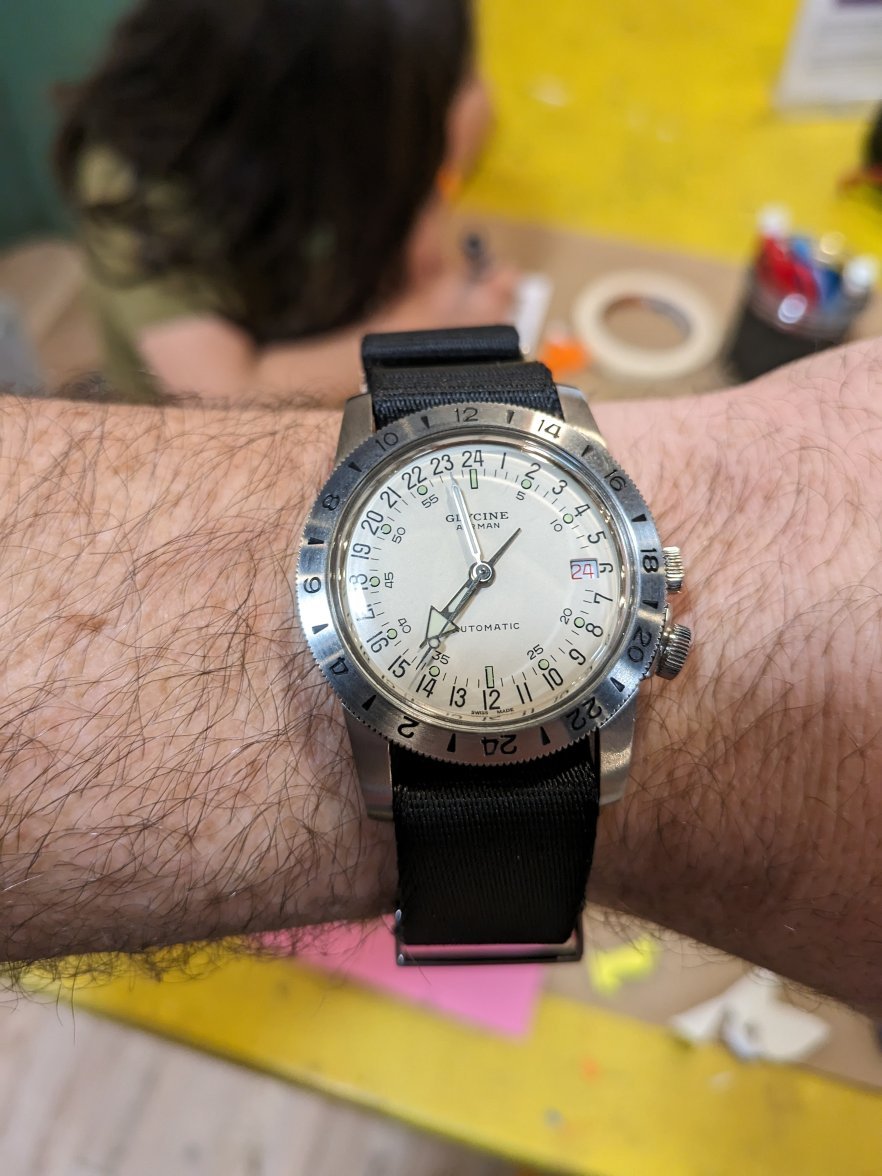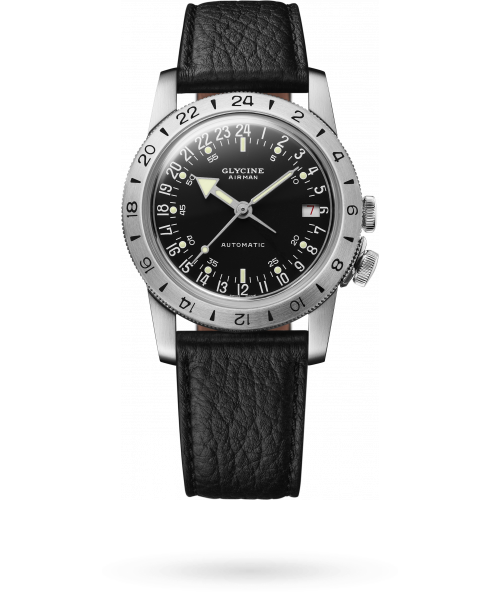Show us your Glycine Airman!
RI Omega Fan
·These are amazing tool watches! I’m loving all the 1956 examples (my birth year).
Do one of you guys want to give a quick primer on how to read the dial? I get it if it’s a 24 hour dial, but it must take some getting used to.
Also, what’s up with that stubby little hand on some of them? Is it just the backside of the hour hand, or does it indicate something? On top of all this, there is a rotating bezel! For some reason, I can’t get my head around this.
Thanks, Pete
Do one of you guys want to give a quick primer on how to read the dial? I get it if it’s a 24 hour dial, but it must take some getting used to.
Also, what’s up with that stubby little hand on some of them? Is it just the backside of the hour hand, or does it indicate something? On top of all this, there is a rotating bezel! For some reason, I can’t get my head around this.
Thanks, Pete
TexOmega
·Set the hour hand to the hour (1-24)......and that stubby one points to the 1-12 hour......cool
RI Omega Fan
·Set the hour hand to the hour (1-24)......and that stubby one points to the 1-12 hour......cool
TexOmega
·pdxleaf
·Think civilian time, which is always 1 through 12. When the hour hand points at any time between 1 and 12, it's the same as a normal watch, eg 5 am is 5.
But when it's afternoon, say 5 in the afternoon, that is 17 in military time (12 plus 5). If 17 is too much math, Glycine gave that little tail that points in the opposite direction, which in this example is 5. Easy peasy.
pdxleaf
·TexOmega
·Speak slowly, I don't read so fast!😁
Baseball is 90% mental, 50% of the time!😁
Baseball is 90% mental, 50% of the time!😁

krogerfoot
·These are amazing tool watches! I’m loving all the 1956 examples (my birth year).
Do one of you guys want to give a quick primer on how to read the dial? I get it if it’s a 24 hour dial, but it must take some getting used to.
Also, what’s up with that stubby little hand on some of them? Is it just the backside of the hour hand, or does it indicate something? On top of all this, there is a rotating bezel! For some reason, I can’t get my head around this.
Thanks, Pete
The only difficulty I've had was a Russian watch with only the odd indices numbered. It was too easy to think it was an hour later than the actual time. The Airman design is justly celebrated for its legibility and utility.
keepsonticking
·These are amazing tool watches! I’m loving all the 1956 examples (my birth year).
Do one of you guys want to give a quick primer on how to read the dial? I get it if it’s a 24 hour dial, but it must take some getting used to.
Also, what’s up with that stubby little hand on some of them? Is it just the backside of the hour hand, or does it indicate something? On top of all this, there is a rotating bezel! For some reason, I can’t get my head around this.
Thanks, Pete
I was just doing some research on production numbers last night. The reason you see so many 1956 watches is that there were WAY more made that year than any other...not sure why. There were two batches: One with the "tail" on the minute hand and one with tail on the hour hand. I believe it was 31,000 total....6000 of the later variety and 25,000 of the early, all 1956. Give or take a few thousand. Comparatively, most other years were less than 5000 total. Some years were just 1000 or 2000. Mine that I am currently working on is a 1960 (below). There were 3000 that year.
Edited:
septentrio
·I was just doing some research on production numbers last night. The reason you see so many 1956 watches is that there were WAY more made that year than any other...not sure why. There were two batches: One with the "tail" on the minute hand and one with tail on the hour hand. I believe it was 31,000 total....6000 of the later variety and 25,000 of the early, all 1956. Give or take a few thousand. Comparatively, most other years were less than 5000 total. Some years were just 1000 or 2000. Mine that I am currently working on is a 1960 (below). There were 3000 that year.
Hello, we all know the table on Glycintennial so please don't represent 5 minutes simple maths on this table as 'research'.

Moreover, this table has been proven to be wrong/inaccurate on many instances. André mentions in his book that the arrow moved to the hour hand in 1955, not 1956. Also, the serial ranges in the table are inaccurate in my opinion, next to the fact that a serial range does not at all indicate an actual production number. Outside of this topic, there are not a lot of 1950s examples to be found - they only pass very rarely. I have not seen a lot and given the interest 1950s examples generate, I'm sure a lot of other enthusiasts have not seen a lot either. I am actually 100% sure there are more Airmans produced in the 1960s then in the 1950s, this is also logical in model evolution, and don't expect a production number for 1956 of more than a couple of thousands max. Or do you think, based on the table, that exactly 99.000 examples were produced in 1964, exactly 80.000 in 1965 and exactly 90.000 in 1966?? 😁 I will look for actual research on production numbers, but I suggest you look into André's book - there is a PDF version online through xs4all.
BTW: nice dial on you project!
Edited:
keepsonticking
·Hello, we all know the table on Glycintennial so please don't represent 5 minutes simple maths on this table as 'research'.

Moreover, this table has been proven to be wrong/inaccurate on many instances. André mentions in his book that the arrow moved to the hour hand in 1955, not 1956. Also, the serial ranges in the table are inaccurate in my opinion, next to the fact that a serial range does not at all indicate an actual production number. Outside of this topic, there are not a lot of 1950s examples to be found - they only pass very rarely. I have not seen a lot and given the interest 1950s examples generate, I'm sure a lot of other enthusiasts have not seen a lot either. I am actually 100% sure there are more Airmans produced in the 1960s then in the 1950s, this is also logical in model evolution, and don't expect a production number for 1956 of more than a couple of thousands max. Or do you think, based on the table, that exactly 99.000 examples were produced in 1964, exactly 80.000 in 1965 and exactly 90.000 in 1966?? 😁 I will look for actual research on production numbers, but I suggest you look into André's book - there is a PDF version online through xs4all.
BTW: nice dial on you project!
Signed,
guy who you schooled
Edited:
James Sadilek
·The serial number list is meant to be a guide. It was compiled by Emre Kiris who has access to factory records; Emre acknowledges that there are inaccuracies. Using 1958 production numbers as a simple example, The range of numbers is 4000. These are not all Airman; Glycine was making other watches at the time, and in fact making other watches all through the Airman production period. For example, I have Glycine 973888, which dates from 1968 according to the list. It is in a gold plated case with a stainless steel back. The case is an EPSA compressor, but no rotating bezel. The movement is a plain vanilla ETA. The private label 12 hour dial has the name of Rivera. The oscillating weight is engraved Nathan's Jewelers. The only indication that this watch is from Glycine is the six digit serial number that is engraved on the case back in exactly the same manner and font as a typical late sixties Airman
About 1958, Glycine made a series of 12 hour watches in the same case as the Airman, with the rotating bezel and wire hack. The movements were ETA with the main plate modified to accept the hack wire. Some of these were labeled Combat, others were Sportsman, and some number were private labeled for Marshall Field & Co.
All of this is to make the point that there is no way, from the published serial number list to determine how many Airman watches were made in a particular year, or what the total production was. Based on my experience, the 1965/1966 period was the most prolific for Airman watches.
As stated above, Airman watches from the fifties are not common. Pre-1955 watches are rare, and Airman with white dials are rare. I do not believe any white dials (or whatever color one uses to describe the light dials) were mad after 1957. Again, this is based on personal experience, I could be wrong.
About 1958, Glycine made a series of 12 hour watches in the same case as the Airman, with the rotating bezel and wire hack. The movements were ETA with the main plate modified to accept the hack wire. Some of these were labeled Combat, others were Sportsman, and some number were private labeled for Marshall Field & Co.
All of this is to make the point that there is no way, from the published serial number list to determine how many Airman watches were made in a particular year, or what the total production was. Based on my experience, the 1965/1966 period was the most prolific for Airman watches.
As stated above, Airman watches from the fifties are not common. Pre-1955 watches are rare, and Airman with white dials are rare. I do not believe any white dials (or whatever color one uses to describe the light dials) were mad after 1957. Again, this is based on personal experience, I could be wrong.
serdal22
·I used to have the cream dial version. I should have kept it, big mistake selling it. Very robust, very functional, very accurate it was. Having 3 time zones is another advantage for sailors and frequent travelers like me.
I saw this watch (few year old brand, manufacture their watches in Japan) on the internet accidentally. When I searched and learned that it was sold out I purchased right away. This piece also has 3 time zones, and fill the shoes Airman emptied 'for now'. ;-) It landed today, and I like it a lot so far:
I saw this watch (few year old brand, manufacture their watches in Japan) on the internet accidentally. When I searched and learned that it was sold out I purchased right away. This piece also has 3 time zones, and fill the shoes Airman emptied 'for now'. ;-) It landed today, and I like it a lot so far:
James Sadilek
·I used to have the cream dial version. I should have kept it, big mistake selling it. Very robust, very functional, very accurate it was. Having 3 time zones is another advantage for sailors and frequent travelers like me.
I saw this watch (few year old brand, manufacture their watches in Japan) on the internet accidentally. When I searched and learned that it was sold out I purchased right away. This piece also has 3 time zones, and fill the shoes Airman emptied 'for now'. ;-) It landed today, and I like it a lot so far:
Your cream dialed Glycine must have been a modern version; having three time zones requires a GMT hand. Vintage Glycine Airman are capable of showing two time zones, not three.
The photographs show a 12 hour watch with a GMT hand and a 24 hour rotating bezel. This is not a 24 hour watch.
serdal22
·Your cream dialed Glycine must have been a modern version; having three time zones requires a GMT hand. Vintage Glycine Airman are capable of showing two time zones, not three.
The photographs show a 12 hour watch with a GMT hand and a 24 hour rotating bezel. This is not a 24 hour watch.
